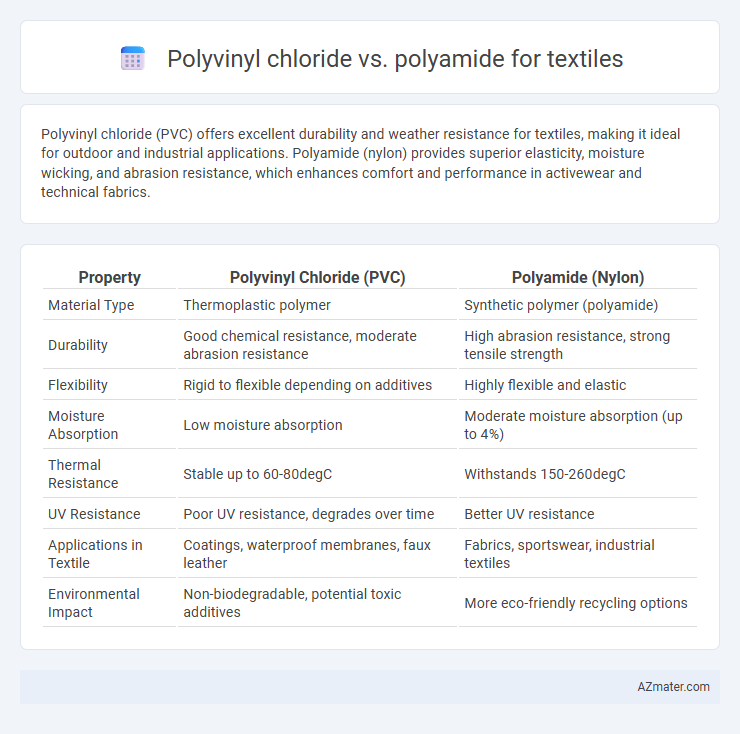Polyvinyl chloride (PVC) offers excellent durability and weather resistance for textiles, making it ideal for outdoor and industrial applications. Polyamide (nylon) provides superior elasticity, moisture wicking, and abrasion resistance, which enhances comfort and performance in activewear and technical fabrics.
Table of Comparison
| Property | Polyvinyl Chloride (PVC) | Polyamide (Nylon) |
|---|---|---|
| Material Type | Thermoplastic polymer | Synthetic polymer (polyamide) |
| Durability | Good chemical resistance, moderate abrasion resistance | High abrasion resistance, strong tensile strength |
| Flexibility | Rigid to flexible depending on additives | Highly flexible and elastic |
| Moisture Absorption | Low moisture absorption | Moderate moisture absorption (up to 4%) |
| Thermal Resistance | Stable up to 60-80degC | Withstands 150-260degC |
| UV Resistance | Poor UV resistance, degrades over time | Better UV resistance |
| Applications in Textile | Coatings, waterproof membranes, faux leather | Fabrics, sportswear, industrial textiles |
| Environmental Impact | Non-biodegradable, potential toxic additives | More eco-friendly recycling options |
Introduction to Polyvinyl Chloride and Polyamide
Polyvinyl chloride (PVC) is a synthetic plastic polymer known for its durability, resistance to moisture, and cost-effectiveness in textile applications. Polyamide, commonly referred to as nylon, is a synthetic fiber characterized by high tensile strength, elasticity, and excellent abrasion resistance. Both materials offer distinct properties, with PVC excelling in water resistance and polyamide favored for flexibility and durability in textile manufacturing.
Chemical Structure and Composition
Polyvinyl chloride (PVC) consists of repeating vinyl chloride monomers with a backbone of carbon atoms bonded to chlorine, giving it rigidity and chemical resistance ideal for coated textiles. Polyamide fibers, such as nylon, are composed of amide linkages (-CONH-) formed through polymerization of diamines and dicarboxylic acids, offering high tensile strength and elasticity in fabric applications. The chlorine atoms in PVC provide durability against environmental degradation, whereas the amide groups in polyamide contribute to moisture absorption and enhanced mechanical performance in textiles.
Production Processes
Polyvinyl chloride (PVC) fiber production involves polymerizing vinyl chloride monomers through suspension or emulsion polymerization, followed by plasticizing and extrusion into fibers, which are then processed for textile applications. Polyamide (nylon) fibers are synthesized via condensation polymerization of diamines and dicarboxylic acids, with melt spinning or solution spinning techniques used to produce strong, flexible filaments ideal for textiles. Both materials require precise control over molecular weight and temperature during processing to optimize fiber properties such as durability, elasticity, and moisture resistance in textile manufacturing.
Mechanical and Physical Properties
Polyvinyl chloride (PVC) offers excellent abrasion resistance and high tensile strength, making it suitable for heavy-duty textile applications, while its rigidity can limit flexibility compared to polyamide. Polyamide (nylon) exhibits superior elasticity, impact resistance, and moisture absorption, enhancing comfort and durability in textile products. The thermal stability of polyamide surpasses PVC, enabling better performance in varying temperature conditions without significant degradation.
Durability and Lifespan
Polyvinyl chloride (PVC) offers high resistance to abrasion, chemicals, and moisture, making it extremely durable for textile applications with a lifespan often exceeding 10 years under moderate use. Polyamide (Nylon), known for its excellent tensile strength and elasticity, provides superior durability in dynamic environments but can degrade faster when exposed to UV light and chemicals, typically lasting around 5-7 years in similar conditions. Choosing between PVC and polyamide for textiles depends on specific durability needs and environmental exposure, with PVC excelling in chemical resistance and longevity, while polyamide offers enhanced flexibility and strength.
Textile Applications and Suitability
Polyvinyl chloride (PVC) is widely used in textiles for waterproof and durable outerwear, offering excellent chemical resistance and flexibility but limited breathability. Polyamide, commonly known as nylon, excels in textile applications requiring high strength, elasticity, and abrasion resistance, making it ideal for activewear and performance fabrics. The suitability of PVC versus polyamide depends on the end use, with PVC favored for protective coatings and polyamide preferred for lightweight, breathable garments.
Environmental Impact and Sustainability
Polyvinyl chloride (PVC) poses significant environmental concerns due to its production process releasing toxic chemicals like dioxins and its non-biodegradable nature, which contributes to persistent pollution. In contrast, polyamide (nylon) offers enhanced durability and recyclability, though its synthesis relies heavily on petroleum-based resources, leading to substantial greenhouse gas emissions. Sustainable alternatives prioritize bio-based polyamides or innovative recycling methods to reduce the ecological footprint compared to conventional PVC usage in textiles.
Cost Comparison
Polyvinyl chloride (PVC) is generally more cost-effective than polyamide (nylon) for textile applications due to its lower raw material and processing expenses. PVC fabrics offer affordability in bulk production, making them a preferred choice for budget-conscious projects, while polyamide's higher price reflects its superior durability and performance characteristics. Evaluating cost versus performance requirements is essential when selecting between PVC and polyamide textiles.
Health and Safety Aspects
Polyvinyl chloride (PVC) in textiles often releases harmful chemicals such as phthalates and dioxins during production and disposal, posing respiratory and skin irritation risks, which raises significant health and environmental concerns. Polyamide (nylon) fibers are generally considered safer as they have lower toxic emissions and better biodegradability profiles, reducing potential long-term health impacts. Safety assessments highlight polyamide's advantage in minimizing exposure to hazardous substances, making it a preferred choice for textile applications with stringent health and safety standards.
Future Trends in Textile Materials
Polyvinyl chloride (PVC) is widely used for its durability, water resistance, and cost-effectiveness, primarily in synthetic textiles for outdoor and technical applications. Polyamide (nylon) offers superior strength, elasticity, and abrasion resistance, making it ideal for performance textiles and smart fabric integration. Future trends indicate a growing demand for bio-based and more sustainable alternatives of both PVC and polyamide, with innovations aimed at reducing environmental impact while enhancing functional properties in textile manufacturing.

Infographic: Polyvinyl chloride vs Polyamide for Textile
 azmater.com
azmater.com